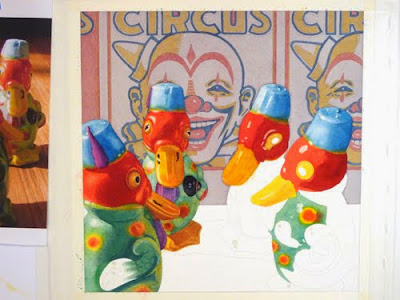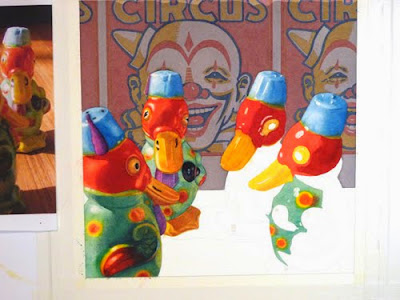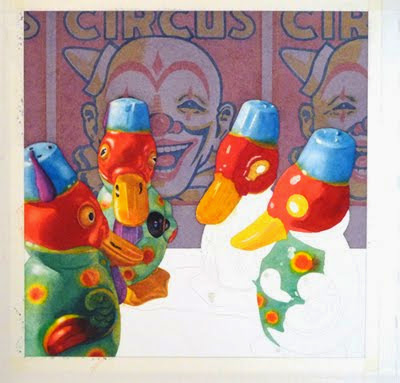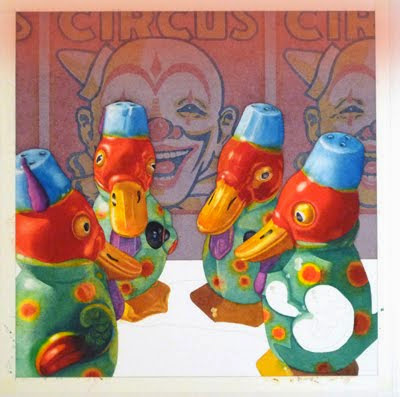 Background trial run
Background trial run
I don't usually work from multiple resources for my still-lifes, preferring to set up a scene, photo it and then crop the best image in Photoshop to serve as my working image. In the case of my most recent painting, Waiting in the Wings, I wanted to set a scene that combined separate elements into a cohesive whole. I started by painting a sample of the background image -- an exercise that chewed up a full day's work time but proved invaluable in deciding how to proceed. It was obvious that sticking to a faithful reproduction of the resource image would not work -- too much distraction from the main characters, the fez-wearing ducks. (To test my composition, I made full-size prints of the ducks, cut them out and pasted them in front of my sample clown.) Plus, the intense colors bled too easily if I tried to run a wash over them. I know I could have chosen to paint the clowns in fluid acrylics, but I enjoy the challenge of creating a painting using only transparent watercolors.
I decided to tone down the background with a warm neutral wash and use muted versions of the original colors. I chose staining colors (quinacridone gold, brown madder, and indigo) and used them quite diluted for the clown's features in case I would need to do further washes on the background. This proved to be a great decision, as I ended up doing at least 6 or 8 washes over the background.
 First stage -- light, but muted color background
First stage -- light, but muted color background
Early on, it became clear that the background was too light and created a visually confusing situation, so I used Photoshop to test a darker background.
 Photoshop trial -- darker background
Photoshop trial -- darker background
Based on that, I ran a couple of mid-gray washes over the clowns. It seemed too blue, so I later ran some quinacridone sienna washes across the area to restore the neutral tone.
 Initial dark washes over the background
Initial dark washes over the background
As I completed more of the foreground, I became less and less satisfied with the background. It was still too light and the muted tone detracted from the light-hearted mood I wanted. I tried a number of Photoshop tricks in my search for a fix. First, I airbrushed orange across the top of the image -- interesting but weak.
 Photoshop trial -- airbrush color
Photoshop trial -- airbrush color
Then I tweaked the center by selecting the area and running a "darker" variation on it. That really popped the ducks into the spotlight, but it was dull and uninspiring.



Very interesting thought process! I enjoyed seeing all that you went through to come to completion. Good for you. I love it when people take time to produce something meaningful as you have here. Congrats on a strong finish!
ReplyDeleteWhat a fabulous post, Chris - its like getting to watch over your shoulder. And for those of us who don't do watercolors, its fascinating to see the process and all the changes you achieve. Hope you do more posts like this in the future!
ReplyDeleteThanks for sharing your process on this one, Chris. It's fez-tastic!
ReplyDeleteI am glad you posted this info... I was immediately taken with the background when you first posted the image but didn't comment at the time... it turned out really well and gives a nice mystique to the piece...
ReplyDeleteThanks to you all for taking time to leave comments! I'm glad this post has been so well-received. I didn't take all these pix with a blog post in mind, but once I had them in hand, it seemed like the logical next step -- a little peek inside the black box!!
ReplyDelete(Is the world ready to be fez-tooned with fezmatics?)
Such an inspiring post! Thank you for sharing the process. Your paintings are always amazing and this was terrific to see your mind at work.
ReplyDeleteThanks, Carrie -- there are days when I wonder if I still have a mind!! ;-D Glad you enjoyed the post!!
ReplyDeleteDitto - enjoyed seeing your process.
ReplyDeleteThanks, Deb!!
ReplyDeleteThanks so much for sharing this process. I sometimes feel like great paintings spring forth fully formed from their creators' minds. It's really helpful to see how you approached this challenge step by step. Thanks, Chris!
ReplyDeleteThanks, Nancy! I think everybody's fondest dream would be for a painting to magically develop as you first envisioned it -- but sometimes the struggles along the way actually make for a more interesting result. Glad you enjoyed the backstory!!
ReplyDeleteChris, what you do is quite fabulous and I love your spotlight feature.
ReplyDeleteSo many wonderful artists....so little time......
Thanks, Mary -- yes, time is the big factor in all of this!! Glad you like the spotlights.
ReplyDelete